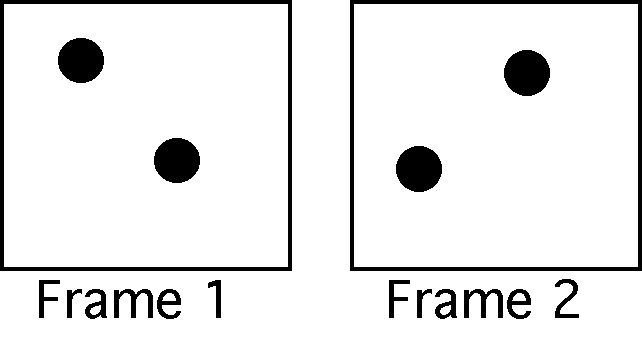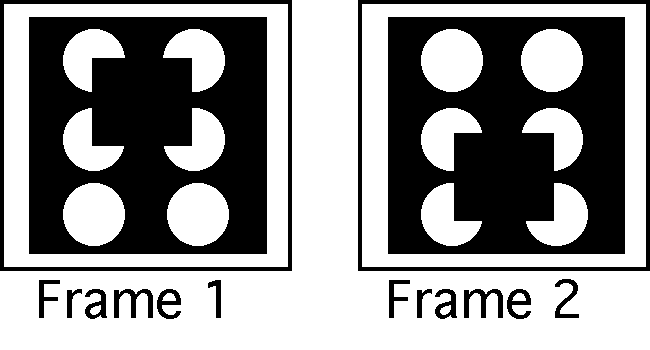
This laboratory explores the phenomenon of apparent motion. When still frames
are rapidly alternated, people often spontaneously perceive motion. By studying
apparent motion phenomena, we can learn about how people subjectively structure
the external world , the assumptions that people make about stimuli when perceiving,
top-down effects in vision, and the specific mechanisms that people use to see
motion. Apparent motion is also an indispensible to the motion picture industry
because movies are nothing more than a series of still frames that are rapidly
displayed.
The computer program for apparent motion does two things. First, it allows you
to create and display apparent motion phenomena. You can design an apparent
motion display, and then present it to yourself and determine the motion that
you spontaneously see. Second, it provides a computational model of how people
see apparent motion. Typically, you will use this program by presenting the
same apparent motion display to yourself and to the computational model, and
observing whether the computer "sees" the same kind of motion that
you do.
The program allows you to draw two static frames, and then alternates them in
a manner specified by experimenter-controlled parameters. The program does not
collect any data from the subject; there are too many possible data that might
be collected. In many cases, the effects are so strong and immediately obvious
that experimenters can use their own impressions as data, and can be fairly
confident that other people will see the displays in the same way. This lab
is designed to have quite a bit of flexibility. The experimenter can create
their own displays with different geometric shapes, each with its own color
and size.
When people see motion between two successively presented frames, their minds unconsciousnly determine which parts from the first frame correspond to which parts from the second frame. When people see two parts as corresponding to each other, this means that they interpret the two parts as coming from the same object. If the two parts are separated from each other, then people will see a single object moving over time.
Determining what parts correspond to each other tells us what parts come from
the same object at different times. However, this task is intrinsically ambiguous.
One part in one frame could correspond to many different parts in the other
frame. Simple experiments will show that people sometimes see two parts as showing
the same object moving over time even if the parts do not have the same color,
size, location, or even shape! Your mind spontaneously figures out what parts
correspond to each other, but underlying this seemingly effortless feat are
sophisticated computations. Your mind uses several constraints in order to try
to determine what parts correspond to each other. Constraints are valuable,
not restrictive things to be avoided, because without constraints the world
is too ambiguous. Constraints allow us to restrict our perceptions to the most
plausible possibilities.
Imagine that there are two frames, each with three circles. Each object from one frame might correspond to any of the three objects from the other frame. Your mind makes assumptions about what objects are likely to belong together:
All of these constraints act together to determine the motion that you will
in a display. None of these constraints is hard and fast. Your mind can often
times overrule these constraints, but they are biases that generally lead people
to see motion in a reasonable manner. Impressively, all correspondences between
all objects are determined at the same time, and the correspondences mutually
influence each. The last two assumptions above make this clear. Whether or not
an object corresponds to another object depends on all of the other objects
and THEIR emerging correspondences.
Experimental Exploration of Apparent Motion
While exploring the human perception of apparent motion, you may want to try
out some of the following displays:
 |
Notice here that you will most likely either see two dots sliding up and down, or two dots sliding left and right. You can see either of these effects by selectively hiding pairs of dots and gradually constrained so that every dot in one frame corresponds to one and only one dot in the other frame. |
 |
This is called the "Ternus Display." The grid is displayed to show you the precise locations of dots. If there is a short blank period between these frames, people typically report seeing three dots moving up and down. This is suprising because some of the dots have EXACTLY the same location in the two frames, and yet people don't see them as stationary. People DO see them as stationary if there is no blank period between frames. What do you think is going on here (HINT: remember the one-to-one mapping constraint)? |
 |
This display can be created with the program although it will require a bit of ingenuity. It combines two illusions: illusory contours (seeing a complete black square even though there are only white "pac-man" shapes) and illusory motion. What do you see when these displays are alternated? What does your perception imply about whether your mind creates illusory contours BEFORE or AFTER it creates apparent motion? |
The computer simulation is a simple neural network that has been designed to implement the assumptions/constraints previously described. In this network, one unit is created for every potential correspondence between two objects. If two frames each have 3 objects in them, 9 units will be created because each of three objects in one frame can correspond to three objects from the other frame. Each unit has an activation, and the more active the unit is, the more strongly the computer "feels" that the two objects connected by the unit should be placed in correspondence. In the simulation, the activity of a correspondence unit is shown by the amount of green in the connection between objects. In accordance with the described constraints, the following principles govern thechange in a unit's activity over time:

The neural network begins with all correspondences' activations set to zero. Then, the units gradually change their activations by the above principles, and as they do so, they will change other units' activations.
When you run the program, you will see a screen that contains a description of Frame 1 and Frame 2. The first thing you will want to do is create the two frames that will make up the animation. To do this, you can select from three different shapes (square, circle, and diagonal line) and three different sizes. You can also color the object in many different ways by selecting the amount of red, green, and blue in the color using the three color sliders. To paint objects on the frames, press the paint button and click on the spot in the frame where you want the object to appear. The appearance of the object will be determined by the color, shape, and size that you have selected. To erase an object, press the erase button and click on the object that you wanted deleted. To move an object, press the move button, and then click on the object you want to move, and drag it to its new location. To copy an object from one frame to the other, press the copy button and click on the object you want copied. Press clear if you want to erase all of the objects, flip to turn on/off the animated alternation of the two frames, and grid if you want a grid to (dis) appear on the screen that can help you position objects. Press info to find out more information about how to use the program. If you want to save two frames that you created, press the save button and select a file name. You can load in previous files that you created by pressingthe load button.
While the two frames are flipping, no button or slider can be altered. You break
out of flipping mode by pressing the mouse button. While the two frames are
flipping, each will appear on the screen for a period of time that you determine
by selecting a value on the slider called duration. There may
also be a time period between each frame during which the screen is blank. You
specify how long this time period is by selecting a value on the blank
time slider.
In addition to the above buttons and sliders, there are other sliders that you
will need to use if you are interested in exploring the computational model
of human apparent motion perception. The sliders color,
size, and shape determine how much the neural network bases
its correspondences between the two frames on each of these properties. The
consistency slider specifies how much the model tries to enforce
the one-to-one mapping constraint. The motion similarity slider
specifies how much the model tries to have objects move in similar directions.
The match slider specifies how hard the model tries to find
a partner for each object. For each of these parameters, as you move the slider
value to the right, the parameter has a greater influence on how the neural
network. The speed slider determines how quickly correspondences
are determined, and the randomness slider specifies how much
randomness is added to correspondence units' activity.
The computational model is turned on/off by pressing the model
button. When the model is turned on, a set of correspondence units is created,
one unit for each possible connection between objects across the two frames.
Each correspondence unit starts with zero activity. On each time step, the activity
of a correspondence unit changes, based on the parameters that you specify.
The strength of a correspondence unit is indicated by its green hue. The computer
predicts that objects connected by bright green lines will be perceived as coming
from the same moving object.
The ghost button allows you to see where an object from one
frame would appear if it were on the other frame. It will appear as a hollowed-out
object on the other frame. If ghost is turned on and the modeling
is on, then rather than drawing correspondences between objects across frames,
the computer will draw correspondence from the objects of one frame to the ghosts
of the objects in the other frame.